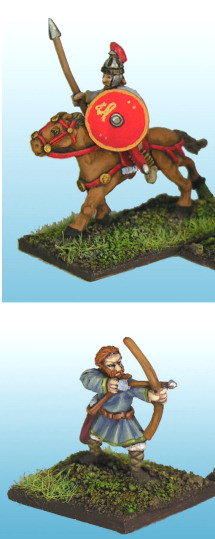
Later German cavalryman and archer painted and based by .
By 300AD the Germans were already a people well known to ancient civilization, both feared and respected for their belligerence and military skill. However, the Migration Period brought these various people into the empire and ultimately into imperial life, some now fighting as horsemen with the support of infantry archers, others still fighting primarily on foot but with a new vigor and new technology, giving them more powerful weaponry. By the beginning of the eighth century they had completely replaced the Roman Empire in the West as rulers of Europe.
These models represent the Germans who were the enemies of, as well as the foundation of, the armies of the Later Roman Empire. There are armoured nobles with spear and shield, their unarmoured followers, also on horseback, infantry with the bow and then the mass of infantry with the spear or the axe and shield. Generals on both foot and horseback are also provided.
They are available both as Western German tribes and as those who were influenced by Eastern dress and fighting styles, such as the Ostrogoths, Gepids and Lombards. Some of the great migratory hordes of the 3-6th centuries were mixed Eastern and Western German tribesmen and so units could also reflect a mix of tribes as the Easterners were being assimilated in.
In addition to fielding their own armies, these Germans can provide a powerful if unruly solid strike force for Roman and Early Byzantine armies.
Sculpted by "Clibinarium."
|

